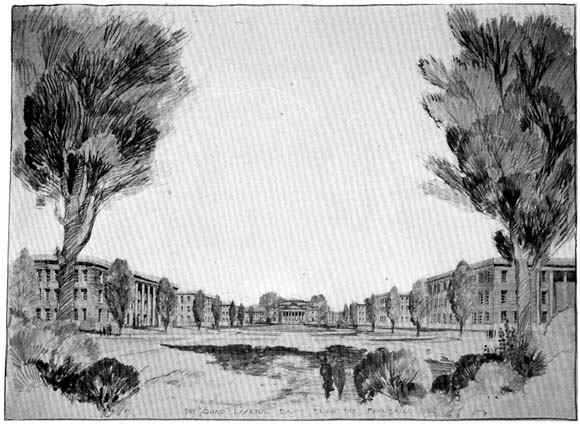necessity, or both. In any event, not
premeditated. It seems to have been born of the
necessity in cities like New York and Chicago, where
the lofty buildings began to make dark caverns of the
streets and city ordinances became necessary to
provide an ever-increasing "setback" as the buildings
assumed loftier and loftier proportions. And, lo and
behold! It suddenly dawned upon artists that this
method of construction greatly improved the beauty and
symmetry of the structure and as a result of it we
have such buildings as the Tribune building, of
Chicago, and the new State Capitol of Nebraska as the
forerunners of a new and purely American culture.
Now we have observed that the
finest examples of landscape that we find in the
vicinity of our cities are the golf courses and,
strange to say, these were never laid out for the
primary purpose of creating landscape but were created
for the sole purpose of providing nine or eighteen,
(as the case may be) fairways that the player might
have an unobstructed view between his tee and his
flag. The net result of which was to create the kind
of a picture that I have just described to you with
the flag for the central figure, supported on either
side by trees or shrubs or drives or creeks or any
other natural work of not sufficient note to detract
from the central feature.
Now to apply my interpretation of
what a picture is or whit a picture ought to be; by
like rules, to a landscape, or what a landscape should
be:
I. A landscape should have a
well-defined and well wrought boundary which would
answer as the artistic frame to our picture; and,
first of all, I might say suggestively that a street
or streets can never be adequate boundaries for a
landscape, for the very simple reason that its creator
may not control the vista on the other side. A
thicket, a river or a screen of shrubs or trees might
answer for a boundary or, where the necessities of the
case require, a landscape may be bounded by a half
block of ground surrounding it and facing it, the
construction and planting thereon being planned for
framing purposes. In other words, the first rule
governing the creation of a landscape is that no
matter where within the enclosure the observer may
stand he may not be permitted to see an objectionable
thing from an artistic point of view.
II. The second important
objective that one should seek to acquire is that
there be no possible avenue of approach or entry into
our landscape scheme through which an objectionable
view could be had, and from every important avenue of
approach the builder should strive to present to the
observer a picture complete in itself with a central
feature (preferably some monumental building)
supported on either side by plantings or lesser
structures that may serve to accentuate the view.
Page 4





